Best Scalable Web Hosting: 5 Providers Compared
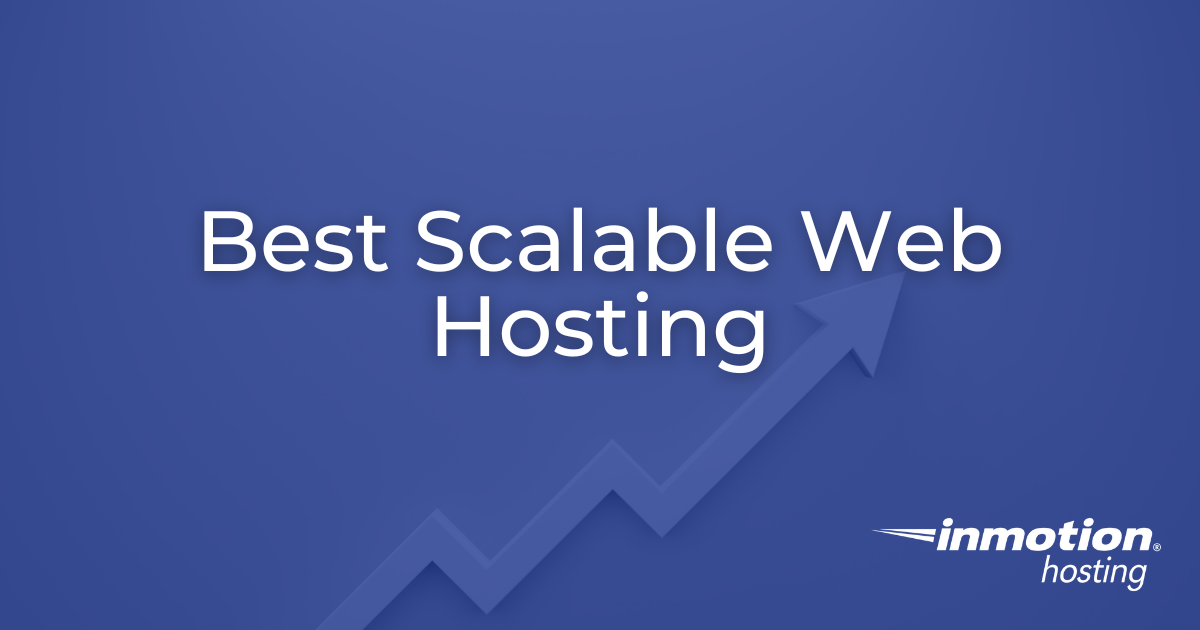
Discover the best scalable web hosting options to support your business growth and maintain top performance. This guide explains key features, compares providers, and offers practical advice to avoid downtime and lost customers as your website traffic increases.
Your growing business needs hosting that matches your goals. If you choose a web hosting plan that cannot grow with you, it can cause real problems. If your website isn’t built to scale with your business, it will slow down, experience more downtime, and lose customers.
Maybe you’ve already felt how frustrating it is to hit your hosting limits. If your site slows down or crashes when lots of people visit, you miss out on money and visitors.
The goal of this guide is to help you avoid bad hosting so your business can grow smoothly. Slow websites can lead to real losses. For many companies, the problem is hosting that cannot handle more site visitors. Scalability is not just for IT teams. It also affects the success of your business.
Understanding Scalable Web Hosting
Scalable web hosting lets your website stay fast and online, even during spikes in site traffic. Your site should respond quickly, no matter how many users visit. This is what separates companies that grow during busy times from those that lose sales at crucial moments.
Good web hosting helps your business grow. If your site is slow or offline, visitors quickly leave. Studies show that if a website takes more than three seconds to load, 53% of people will give up and try another site. Scalability matters because a fast website keeps your money and reputation safe.
Hosting can grow with your business in two main ways:
- Vertical scaling: Increasing the power of a single computer. It’s like getting a better, faster laptop.
- Horizontal scaling: Adding more computers to share the workload. It’s like opening more lines at a store checkout to help more customers at once.
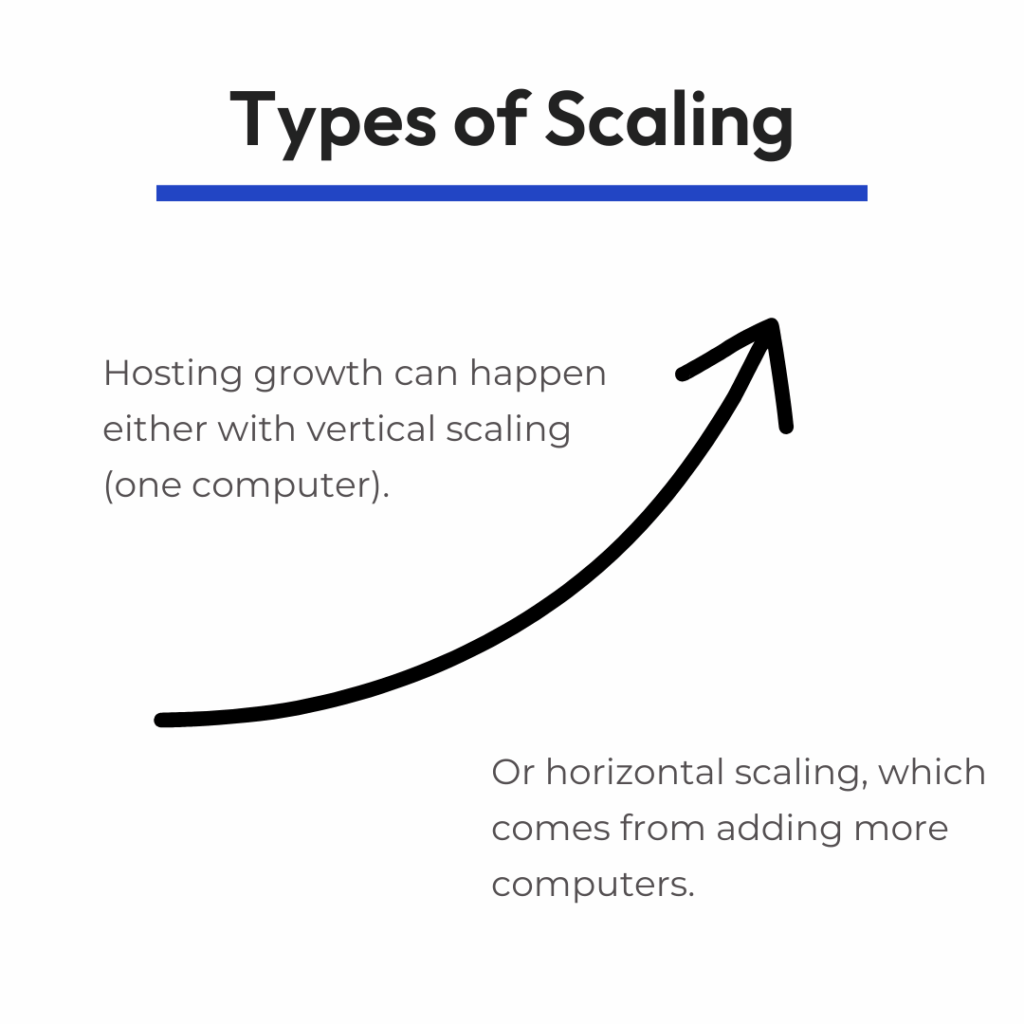
A growing website can face a variety of obstacles. If your hosting plan has low memory, stores files on slow drives, or the database becomes too heavy, your site will slow down. Sometimes the hosting company limits your resources when things get busy, especially on shared servers. These problems make your website slow just when you need it to work well.
Nearly 70% of online shoppers leave slow sites. That’s why choosing scalable hosting is important if you want to grow your online business.
Top Scalable Web Hosting Providers Compared
We reviewed hosting companies by looking at uptime, scaling tools, prices, and support. We also checked how they divide up computer resources. All these things matter, especially during your most important sales or launches.
Uptime promises are about more than just numbers. Most companies promise 99.9% uptime, but every lost minute can cost you money. Make sure your provider provides a clear guarantee for uptime.
Plans and prices can vary. Some companies charge monthly, others let you pay as you grow, and some offer custom options for bigger teams. Knowing your options helps you control spending and avoid surprise bills.
Clear resource limits make planning simple. The best hosting companies tell you exactly how much processor, memory, and bandwidth you get. Be careful with companies that hide what you are paying for.
InMotion Hosting
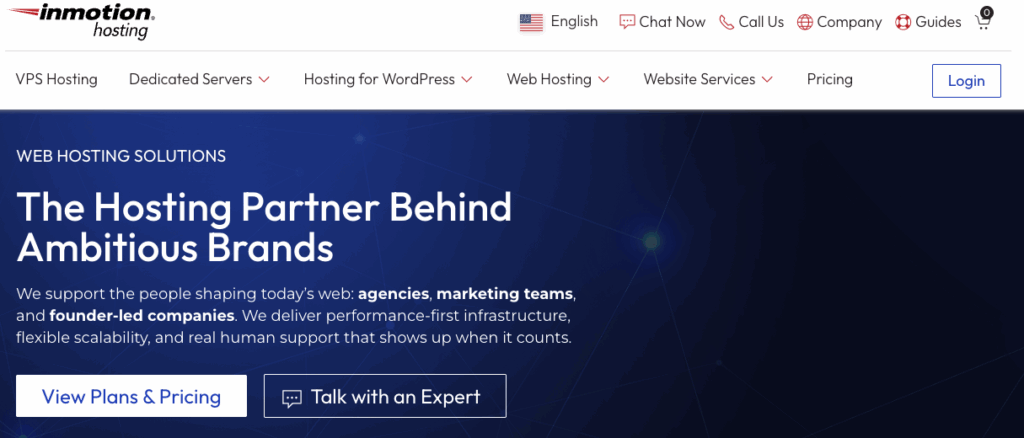
Many businesses turn to hyperscale providers like AWS, Google Cloud, or Azure for scalability, but these platforms often introduce added complexity, hidden costs, and the need for technical expertise. InMotion Hosting offers a different approach: fully managed cloud hosting that delivers the same performance benefits while keeping the focus on your business instead of your infrastructure.
With NVMe-powered storage, Max Speed Zones™ for global performance, and instant, no-downtime scaling, your site stays fast and reliable as traffic grows. Security, monitoring, and backups are built in, so you don’t have to stitch together solutions or hire a dedicated IT team just to keep things stable.
Another overlooked factor in cloud hosting is how non-human traffic, like AI crawlers and bots, can consume resources and degrade performance. InMotion Hosting addresses this by helping filter unnecessary requests so your real visitors always experience fast load times.
Key Features:
- NVMe infrastructure with instant scaling and zero downtime.
- Transparent pricing without unexpected transfer or bandwidth fees.
- 24/7 human support from real people.
- Built-in monitoring, security, and backups for peace of mind.
- Traffic optimization that prioritizes real user experiences over automated bot load.
InMotion Hosting is engineered for speed and stability, but equally focused on accessibility. It brings enterprise-grade performance within reach for businesses that want to grow without getting bogged down in the technical challenges of managing servers. In fact, InMotion recently introduced Large Deployment Enterprise Solutions, designed for businesses that need to scale entire teams or applications across hundreds of servers.
ScalaHosting

ScalaHosting combines cloud infrastructure with NVMe SSD storage, its own management panel called SPanel, and security features designed for stability. Each customer gets dedicated cloud resources, which helps prevent performance slowdowns during traffic spikes.
SPanel is lightweight and designed to be approachable, giving website owners a simpler alternative to cPanel. As traffic grows, it allows resources to be added easily, which makes it appealing for small businesses that want control without unnecessary complexity.
Key Features:
- NVMe SSD storage for faster site performance.
- Dedicated cloud resources that maintain stability under heavy traffic.
- SPanel management system as a streamlined alternative to cPanel.
For users who value simplicity, ScalaHosting offers a good balance of performance and accessibility. However, its smaller ecosystem and limited data center reach may be less suited to businesses planning for global expansion. Solutions like InMotion Hosting provide a broader foundation for growth, combining ease of use with stronger scalability options.
Cloudways
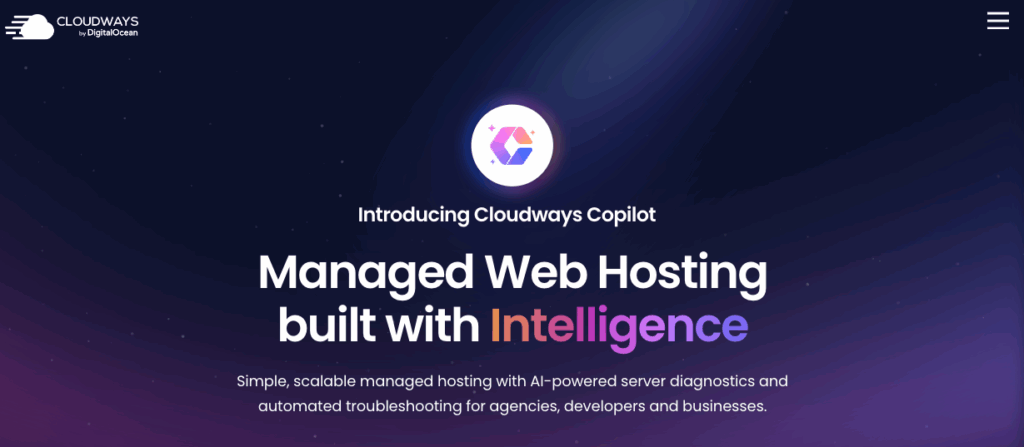
Cloudways delivers flexibility by running managed hosting on top of major cloud providers such as AWS, Google Cloud, and DigitalOcean. This setup means businesses can take advantage of top-tier infrastructure without managing the technical details directly.
Its platform includes monitoring, backups, and security, all designed to keep applications stable even during sudden traffic increases. Developers appreciate Cloudways’ advanced tools, while businesses benefit from uptime reliability and the ability to scale quickly.
Key Features:
- Managed hosting built on major cloud platforms (AWS, GCP, DigitalOcean, etc.).
- Includes security, monitoring, and backups.
- Developer-focused tools and flexible scaling options.
Cloudways offers an appealing middle ground between raw cloud services and fully managed hosting. Still, pricing can climb quickly as more resources are added, and essential services like email hosting are not included. InMotion Hosting takes a more comprehensive approach by pairing advanced performance with transparent pricing and additional business essentials. Thus, it reduces the need to piece together services from multiple providers.
Kinsta
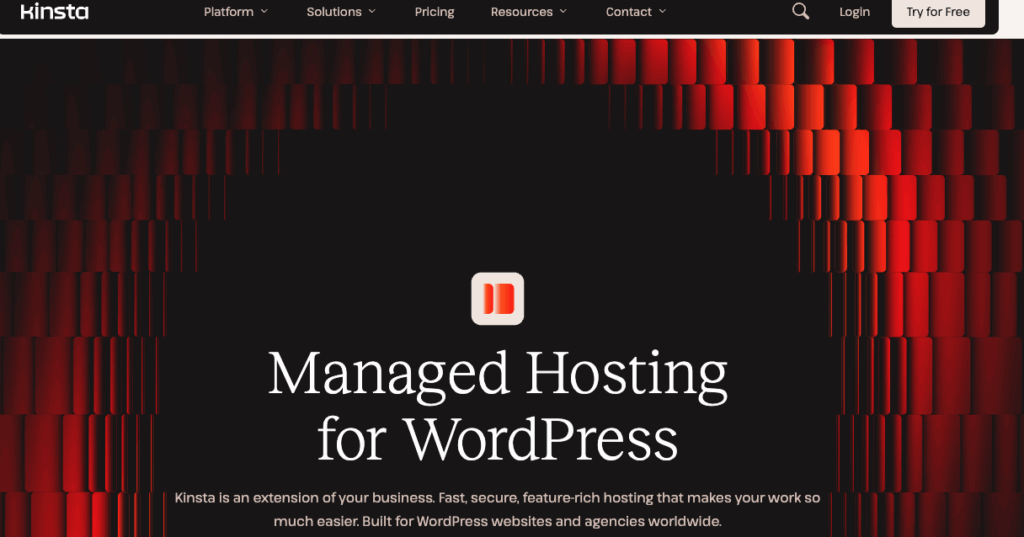
Kinsta uses Google Cloud’s premium-tier network and isolates every customer site in its own container. This setup improves security and ensures resources aren’t shared. They also provide a MyKinsta dashboard for simplified management and analytics.
Key Features:
- Built on Google Cloud Platform’s premium-tier network.
- Isolated container setup for stronger security and performance.
- MyKinsta dashboard with developer-focused tools and analytics.
While this setup is well-suited for WordPress-focused businesses, many growing companies need hosting that can support multiple platforms and applications. This is where managed cloud hosting options, like those from InMotion Hosting, provide greater flexibility for long-term growth.
Hostinger

Hostinger emphasizes affordability and uses LiteSpeed web servers, NVMe storage, and a global CDN for faster performance. It’s positioned as beginner-friendly with its custom hPanel interface.
Key Features:
- Budget-conscious pricing paired with LiteSpeed web servers.
- NVMe storage for faster load times.
- Global CDN for better worldwide performance.
- Beginner-focused management with hPanel.
This makes Hostinger a good entry point for new site owners, but businesses with more ambitious plans often find themselves limited when it’s time to expand. Managed cloud hosting solutions, like InMotion Hosting, are designed to scale smoothly, so businesses don’t have to start over when their needs outgrow basic plans.
Cloud Hosting Scalability
When it comes to cloud hosting, the biggest names are Amazon Web Services (AWS), Google Cloud Platform (GCP), Microsoft Azure, and DigitalOcean. These providers power much of the internet today, and their platforms scale almost instantly. You can add more memory, processing power, or storage within minutes. This is ideal for traffic surges during product launches, seasonal sales, or special events. Pricing usually follows a “pay as you grow” model, which means you only pay for what you use.
That flexibility is powerful, but it comes with trade-offs. Costs can increase quickly if you don’t monitor usage carefully. Many cloud hosts also charge for data transfers between regions, which can add unexpected expenses. Additionally, most platforms require a level of technical expertise. If your team focuses on design, content, or marketing, running servers on AWS or Azure may feel like another full-time job.
To solve these challenges, many businesses use managed hosting providers. These companies handle server management, security, backups, and scaling, while still giving you the performance of enterprise-level cloud infrastructure. This way, you get the best of both worlds: fast growth when you need it, without the headaches of managing raw cloud systems.
Comparing Major Cloud Hosting Solutions
Amazon Web Services (AWS)
Key Features: Global infrastructure, near-instant scaling, wide range of services.Many organizations turn to AWS for power and reach, but the complexity of setup and cost management often demands dedicated technical staff, something smaller teams may not have in place.
Google Cloud Platform (GCP)
Key Features: Premium network backbone, AI and analytics tools, global reach.The platform is built for large-scale deployments, but navigating its wide range of services can be overwhelming for businesses that just need a reliable, scalable hosting foundation.
Microsoft Azure
Key Features: Seamless integration with Microsoft products, enterprise-grade scalability.Azure is a natural fit for IT-heavy organizations already using Microsoft’s ecosystem. For smaller teams, though, the enterprise-first design often means added complexity they don’t need.
DigitalOcean
Key Features: Developer-friendly, simple pricing, fast scaling.DigitalOcean stands out for simplicity and price transparency, but it often lacks the enterprise-grade features and support needed as businesses move from startup mode into long-term growth.
InMotion Hosting: A Smarter Cloud Alternative
While the big cloud platforms are powerful, InMotion Hosting offers a more accessible path to cloud scalability. You get the benefits of high-speed SSD storage, Max Speed Zones for global reach, and resources that scale with your business, without the hidden costs or steep technical learning curve.
One challenge often overlooked in cloud hosting is non-human traffic, like AI crawlers and bots, which can slow your site or inflate your resource usage. As InMotion’s research shows, managing crawler traffic is now part of true scalability. The right host should help you filter unnecessary bot requests so your real customers always get fast load times.
Unlike raw cloud platforms where you’re left to manage servers yourself, InMotion Hosting provides fully managed cloud hosting. That means monitoring, security, and backups are built in. Upgrades happen with zero downtime, so your site can grow smoothly without disruption. And unlike AWS or Azure, you won’t need a dedicated IT team just to keep things running.
Pros:
- Business-grade infrastructure with easy, no-downtime scaling
- Transparent pricing without hidden fees for bandwidth or transfers
- Personalized customer support based in the U.S.
- Optimized for both beginners and growing businesses
Cons:
- Not as many global data centers as AWS or GCP (but Max Speed Zones close the gap for most users)
Why InMotion comes out on top: You get the stability and scalability of cloud hosting, paired with clear pricing and expert support. This lets you focus on growing your business, while InMotion Hosting takes care of the servers.
153% Increase in WordPress Performance
See how InMotion Hosting helped Amacor Printz achieve a 153% performance boost with our Managed WordPress services. By leveraging W3 Total Cache, we optimized their WooCommerce site for peak efficiency. Let us do the same for you!
Read the Case Study
Why Traditional Hosting Often Fails Growing Businesses
Shared hosting is a common choice for start-up companies. One computer’s resources are shared among many customers. The limits of these plans are not always clear when you sign up. When lots of people need power at the same time, everyone slows down or even loses connection. Even if you stay within your own plan’s limits, your site can still become slow.
In simple hosting plans, a sudden increase in visitors can lead to “throttling.” This means your provider will slow down your website or set strict limits. They do this to protect their systems, but it causes problems for your business. It often happens right when you most need more speed and power.
You might also face the “neighbor effect.” If another person on your server uses lots of resources, your site can slow down or even crash. You cannot control how others on the server affect you.
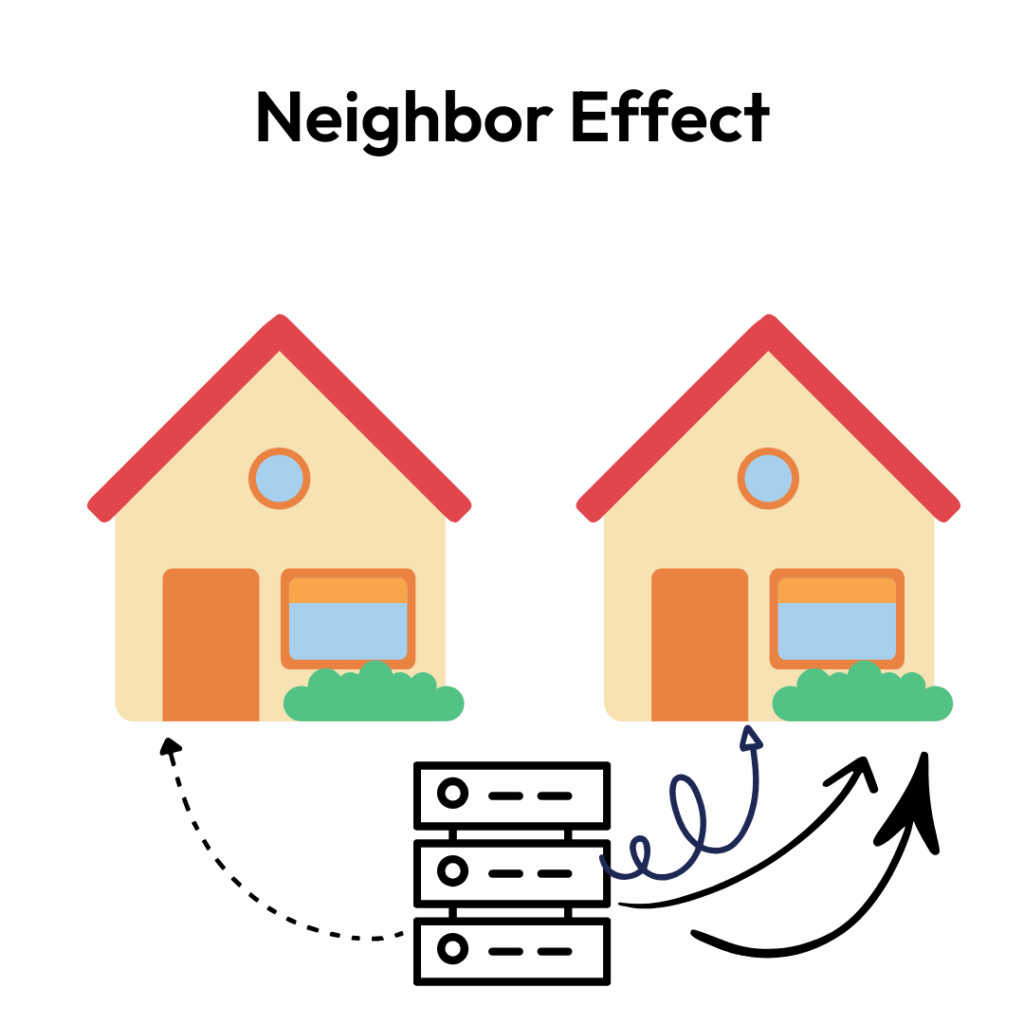
However, scaling by hand is too slow for busy businesses. With many hosts, you must ask for support or change settings manually whenever traffic increases. By the time you finish, you may have already lost visitors.
Choosing the cheapest host at first can mean spending more later. You will waste time fixing problems that better hosting would have avoided. Issues with hosting also waste your marketing money.
Better hosting companies avoid these issues by making it easy to upgrade. They give you your own resources and use smart systems. Your site’s performance does not depend on what others do. This keeps your business, agency, or online store running fast during big launches or campaigns.
Technical Features That Enable True Scalability
Certain features make scaling easy and keep your site running well, such as:
- NVMe SSD storage: Makes your pages load faster and speeds up data searches.
- Server-side caching (Redis, Memcached): Delivers your pages more quickly.
- CDN integration: Puts your site’s files closer to visitors all over the globe for fast loading.
- Database optimization: Makes your site respond quickly, even in busy times.
- Load balancing: Shares visitor traffic across many computers to avoid overload.
- RAM and CPU allocation: Gives you steady performance during sales and campaigns.
The best hosting providers use these tools together for dependable service, even when your business grows quickly. But while these features handle the basics of speed and stability, developers often need a different set of tools to manage growth more directly.
Developer-Friendly Scaling Features
Technical teams may need special features to grow and update sites quickly. These include:
- Git integration: Lets you track code changes and quickly undo mistakes.
- Staging environments: Allows you to test site updates before you go live.
- Command-line tools: Make tasks faster to run and repeat.
- API access: Allows different programs to work together for automatic scaling.
- PHP version management: Helps keep your site secure and speedy.
- Database scaling: Lets you copy or split your database for backup and speed.
These developer tools provide flexibility and control, making it easier to test, adjust, and deploy changes without risking downtime. However, not every business relies on an in-house development team. For many companies, the real value of scalability shows up in how hosting supports their unique type of business.
Scaling for Different Business Types
Every kind of business faces different growing pains. Here’s how scalable hosting helps with your day-to-day work, no matter what you do:
- eCommerce websites: Handle lots of orders and safe payments. Good hosting keeps shopping carts and checkout pages working, even during busy times like holidays or special sales.
- Content-heavy sites: These include blogs or portfolios with big images and videos. Fast hosting and good media tools keep these sites loading fast.
- SaaS businesses: Must keep thousands of logins working at once, and hosting needs to be fast and secure so everyone can use the service without trouble.
- Media sites: Sites for news or trending stories can get lots of visitors all at once. Scalable hosting helps you stay online during these rushes.
- Membership sites: These must handle many people logging in safely at the same time. Fast loading and secure accounts keep members happy as your group grows.
- Global businesses: These serve people in many countries. CDNs and different data center choices let your content load faster for everyone, everywhere.
- Seasonal businesses: Stores or agencies with big events need lots of power during certain times. Good hosting ensures your site is ready for big days, like holiday sales or launch parties.
This isn’t just for tech companies. The right host adapts to your needs, whether you’re selling products, running client campaigns, or launching new services, so your site can grow at the same pace as your business.
WordPress-Specific Scaling Considerations
Many agencies and marketers use WordPress to build websites. Growing WordPress sites need a few special tricks, and each one helps remove common roadblocks to performance.
- Object caching: Tools like Redis or Memcached quickly store and show database results. This makes your site load much faster during busy times.
- Database optimization: Cleaning up old data and keeping tables neat makes your site work better as it grows. Adding “read replicas” for popular sites can help too.
While caching and database care improve raw performance, your choice of plugins and themes also plays a major role in how well WordPress scales.
- Smart plugin choices: Choose fewer, better plugins. This keeps your site quick, even as it grows bigger. A bad plugin can slow everything down.
- Theme optimization: Lightweight, well-built themes load fast for visitors. You can look good and be quick at the same time.
For WordPress stores, performance becomes even more critical. WooCommerce sites need hosting that can manage both traffic spikes and sensitive transactions.
- WooCommerce scaling: If you run an online store, you need a server that can handle many shopping carts and safe payments at once. Always be ready for busy sale days.
Even with the right plugins, themes, and store setup, some businesses prefer not to manage all the technical details themselves. That’s where managed WordPress hosting comes in.
Managed WordPress hosting: With Managed WordPress Hosting, much of the scaling is handled for you. That includes security patches, plugin updates, and even performance optimizations. InMotion Hosting’s WordPress plans include features like automatic backups, server-level caching, and optimized PHP configurations. That means you can grow your site without worrying about breaking something behind the scenes.
Finally, some providers build infrastructure designed only for WordPress. These hosts can take scaling further by bundling in performance, security, and support that’s tuned to WordPress specifically.
- WordPress-optimized infrastructure: Some hosts are built just for WordPress. They often include built-in speed boosts, safety, and support. That means less worry for your whole team.
WordPress sites can handle millions of visitors if you choose the proper setup and host. By combining caching, optimization, and the right hosting plan, your site, agency, or brand will stay fast and reliable as you grow.
How to Plan Your Hosting Scalability Strategy
Choosing the right hosting option is only the first step. You also need a simple plan for growing, so you don’t hit limits when your business gets busy. A hosting scalability strategy is your plan for handling more visitors, bigger databases, and more needs. This saves you from downtime or panic fixes.
Traffic Projection Methods
To plan, start by estimating the amount of traffic you might get in the future. Tools like Google Analytics, Search Console, and CRM records show trends from before. Look at your marketing calendar and past busy seasons to spot incoming traffic spikes. For big events, like a new product, build plans for what happens if things go better than expected, worse than expected, or just normal.
Resource Utilization Baseline
You cannot plan well if you do not know what you use now. Track your use of processor power, memory, and bandwidth. Use your hosting dashboard or simple tracking tools. These help you find any weak spots when you get more visitors. Knowing your current use helps you make smart choices later.
Growth Timeline Planning
Match your scaling plan with your business schedule. Plan upgrades before key dates, like big sales, campaigns, or special offers. If you’re preparing for Black Friday, be sure everything is set up ahead of time. Always treat hosting as an important part of your growth, not just a tech detail.
Budget Allocation
Many companies treat hosting as just a small tech cost, but it is a key part of your business. Add scalable hosting to your growth budget, not just your IT budget. Compare fixed-price packages and “pay as you grow” options. Choose what fits your plans best. When you see hosting as a growth tool, it is easier to spend a little more upfront.
Implementation Roadmap
A good plan is great, but you need simple steps to make it happen. Here’s how to switch to scalable hosting as easily as possible:
- Pre-Migration Preparation: Before switching hosts or upgrading, back up everything. Make sure your apps and plugins will work, and fix your DNS (internet address) settings for an easy switch.
- Testing Protocols: Test your new hosting plan for speed, safety, and heavy use. Use simple tools like Apache JMeter to “pretend” there are lots of visitors and make sure your site will not crash.
- Data Migration Best Practices: Use tested tools to move your data. Move in steps, not all at once. This cuts downtime and keeps more backups in case you need them.
- DNS and Downtime Minimization: Set your DNS Time to Live (TTL) to a low number, a few days ahead of your move. This way, any address changes get updated fast, and your downtime is short.
- Post-Migration Verification: After moving, check if your site is live. Make sure your security certificates are working, and ensure your site loads quickly. Check your site logs and database for any problems.

Real Business Results from Proper Scaling
When your site stays fast while you grow, you get real business results. Upgrading your hosting can even double your sales during busy times. Even a short delay, like one-tenth of a second, can cut your sales by seven percent. Speed and reliability matter. They help you win more clients, get more business, and let your team focus on new ideas instead of fixing tech headaches.
Here is a simple story. An online store grew its sales by 32% after switching to scalable hosting. Before the switch, their old host could not keep up during big sales. The site would crash, and they would lose money. With scalable hosting, they hold big promotions without worrying about outages.
Making the Right Scalable Hosting Decision
Choosing scalable hosting ensures your online setup matches your real business plans. The best host balances uptime, flexible resources, transparent pricing, and expert support. Companies that plan for scaling grow without trouble. Others risk website outages, lost sales, and additional technical issues in the future.
When picking a scalable web host, focus on these things:
- Uptime promises with real guarantees
- Elastic resources that grow with your traffic
- Performance under load from caching, smart delivery systems, and fast hard drives
- Clear costs with no surprise slowdowns
- Personal support to help when you need to scale
Scalable hosting protects your brand, keeps your site fast, and saves you from last-minute panics. You’ll be ready for today’s busy times and tomorrow’s growth.
Every business is unique. Startups should look for flexible, low-cost plans that are easy to upgrade. Medium-sized companies want reliable growth with easy server management. Large businesses need custom plans and personal, around-the-clock support.
If you invest in a scalable host now, you can avoid the challenges and costs of moving your website later. Your hosting becomes a tool that helps you grow, instead of holding you back.
Ready to grow without limits? Get started with hosting solutions made for businesses that want to keep moving forward.
Seamless Website Migrations Done Right – For Free
Moving your website shouldn’t be stressful. InMotion Hosting is the #1 choice for website migrations, offering free expert migrations for cPanel, WordPress, and even complex server-to-server transfers. Let our team handle the heavy lifting so you can stay focused on your business.
Start Your Free Migration Today


